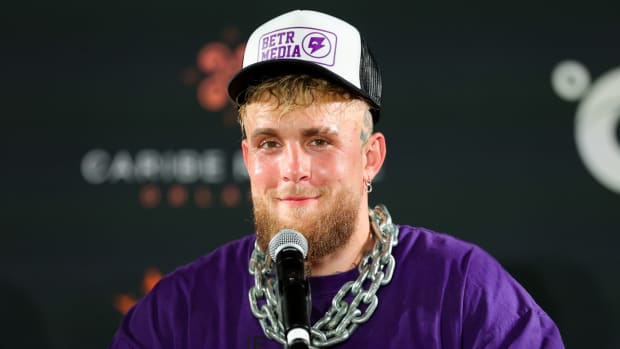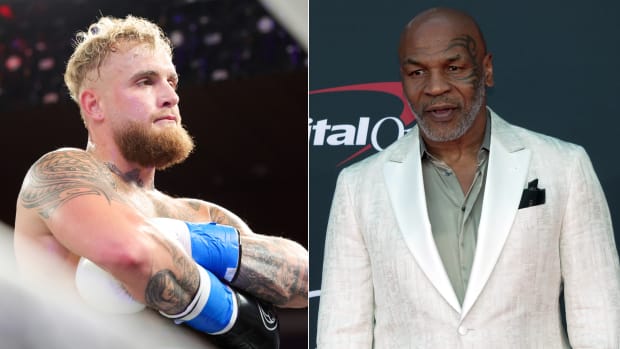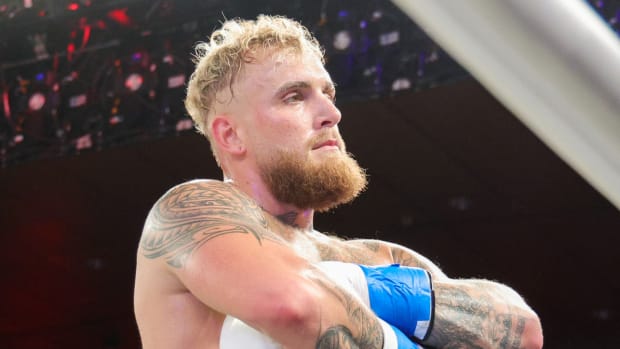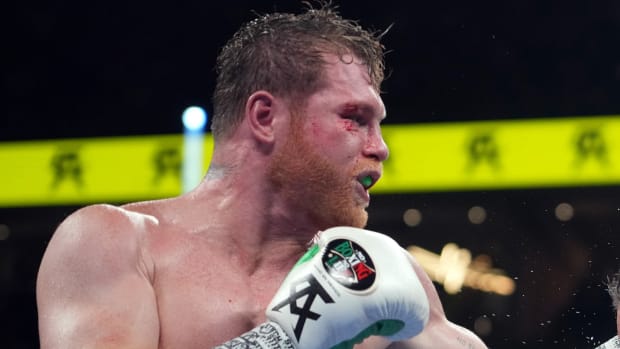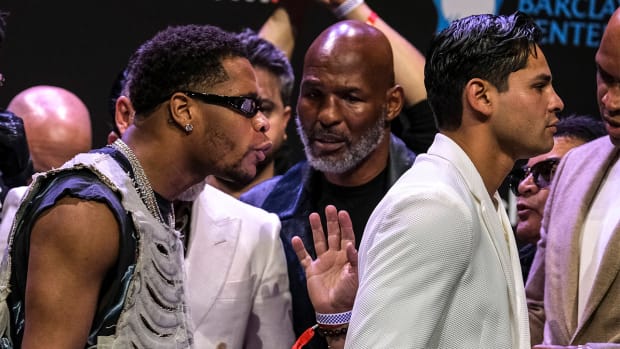Mikey Garcia Is Set to Define the Next Era of Boxing
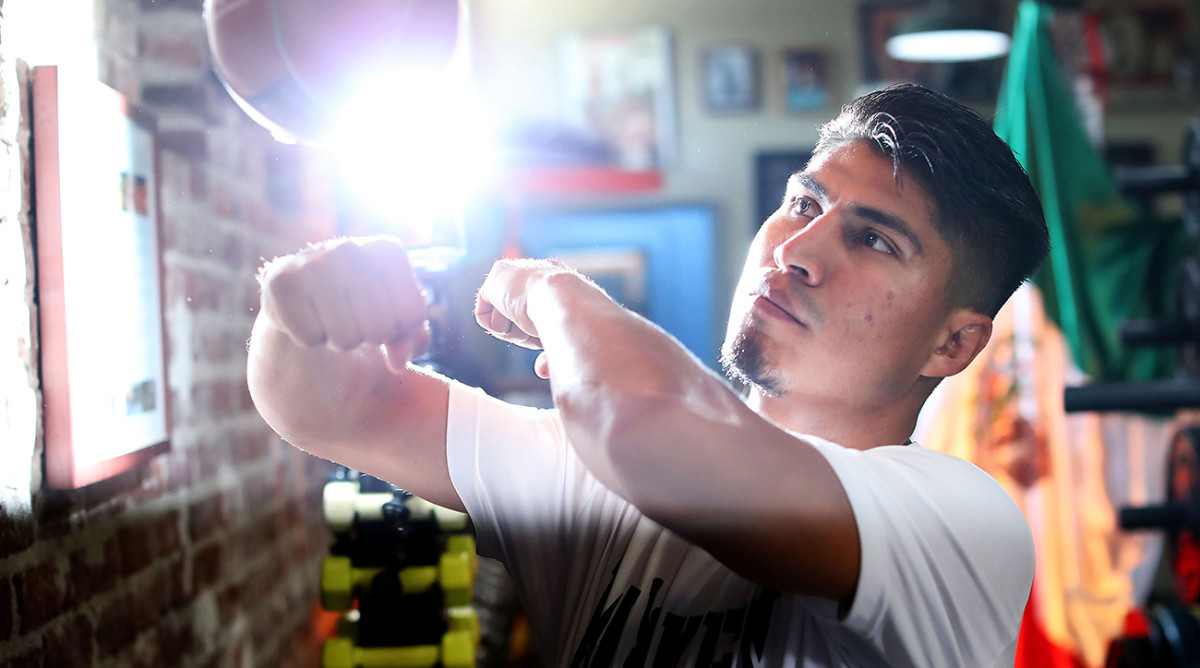
Mikey Garcia is on the phone from Los Angeles, where he will fight Robert Easter Jr. in a lightweight unification bout on Saturday at the Staples Center. He's told the premise of this column, that because he is only 30 years old, and because he can slide up and down in some of boxing's most relevant and interesting divisions, and because he's not tied to any one promoter, he more than any other boxer may define what the post-Mayweather, post-prime-Pacquiao era of boxing looks like.
"The next few years will be the best of my career," he says. "There's no other boxer who's in a position like I'm in."
He's not wrong. There are fighters (Vasiliy Lomachenko, Terence Crawford, Gennady Golovkin) who rank above Garcia on most pound-for-pound lists. There are more accomplished boxers like Golovkin with his record tying 20-straight title defenses; more well known boxers, like the immensely popular Canelo Alvarez; and more active fighters, who didn't like Garcia lose two peak years over a promotional spat. But none of those boxers are situated like Garcia is currently situated: high on the P4P lists but with more flexibility and possibility than his counterparts. "I want to leave my name cemented in the history of boxing," he says.
It's all there for Garcia, who didn't fight from January 2014 until July 2016–the two worst years, he says, of his professional life. Garcia was delayed by a protracted legal battle with Top Rank Boxing, his former promotional company, and rather than simply finish out his contract, he sued Top Rank and waited to box again until they reached a settlement.
He has fought four times since in a way that's indicative of what's possible for him in the years ahead. 1) Tune-up TKO of Elio Rojas. 2) Snagged lightweight belt in old division by knocking out Dejan Zlaticanin. 3) and 4) Moved up to super lightweight, beating Adrien Broner and Sergey Lipinets, securing two belts in that division. Now, he slides back down to lightweight to unify with Easter.
The layoff, Garcia says now, actually helped more than it hindered him. For two years, he didn't sustain any real punishment, and while he hated not fighting, in his absence the divisions he now looks to fight in–the four slots between 130 and 147–were stocked with new, exciting champions. That could mean potential match-ups with Gervonta Davis (130), Lomachenko (130, 135), Maurice Hooker (140), Crawford (140, 147), Danny Garcia (147), Keith Thurman (147) and Errol Spence Jr. (147), among many others. Garcia is the only boxer with that kind of range and thus that kind of possibility, should 1) 147 not be too big for him; it may be and 2) he continue to win.
"We've seen other fighters' careers take off in similar situations," Garcia says. "Like Oscar De La Hoya after he left Top Rank. Or Floyd Mayweather after he left Top Rank. Or Miguel Cotto after he left Top Rank." He pauses, conveniently having left out the work that Top Rank did to build those fighters, then adds, "I'm not saying there's a pattern, but those guys all did a lot better after they left there, too."
Garcia has a point there, and it speaks less to Top Rank and more to boxing's typical model, where promoters retain the bulk of the control, while often fighting with each other, limiting the best-vs.-best type bouts. Because Garcia is not tied to any one promotional company, he's also not tied to only fighting any one promotional company’s opponents. He can meet with a former Swiss banker (Richard Schaefer), a titan in concert promotion (Al Haymon), the founder of the UFC who wants to dabble in boxing (Dana White), the Golden Boy himself (Oscar De La Hoya), a rising promoter (Eddie Hearn) and a baseball legend (Derek Jeter).
The boxer has met with all of those folks, in fact. He convened with Jeter twice, including once in Florida, where Jeter now runs the Marlins. Garcia says Jeter told him he wanted to bring boxing back to South Florida, and they continued to explore what's possible there when they met again recently at the ESPYs in Los Angeles.
Garcia says he took all those meetings to better understand what might be possible for him, not to sign with any one company at this point in time. He wants to retain control, borrowing a page from Mayweather's Money playbook. "I'm not saying no," Garcia says. "I'm just in a great position. I'm open to anything. I want to learn from these guys."
Stephen Espinoza, the GM for Showtime Sports and its boxing czar, says Garcia's impending career path reminds him some of Roy Jones Jr., who started as a middleweight champion and fought all the way up to heavyweight. Which is why Espinoza doesn't dismiss Garcia's goal of fighting Spence, a top welterweight but also someone who competes in a higher division than Garcia has fought in before. Point is, Garcia has that choice and he can make it at the perfect time.
"There's a void in boxing right now for somebody to really own that top spot," Schaefer says. (Handlers for Golovkin, Lomachenko and Crawford may disagree.)
"I mean, be the face of the sport," Schaefer says. "Not just in the Hispanic market, like Canelo, and not just with the hardcore boxing fans like Golovkin is. Mikey is skilled, he's undefeated (38-0), he has power (30 knockouts), he's bilingual, his family is boxing royalty…" He trails off. "He's the perfect guy to represent boxing moving forward."
There's always a void when a boxing star retires, accompanied by the usual silly handwringing over whether the sport will in fact finally die. Who-will-replace-Tyson gave way to who-will-replace-Oscar, which has given way to who-will-replace-Floyd. Boxing is more interesting now than when Mayweather retired and when he un-retired, and that's at the heavyweight level, for sure, but also in the weight classes clustered between 130 and 147.
Garcia represents the future there, which means he could embody boxing's future, too. How his own career unfolds may ultimately decide how the post-Mayweather era comes to be. It may be the Mikey Garcia era, if all falls right.

